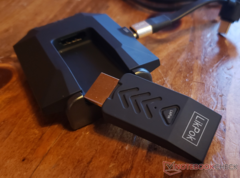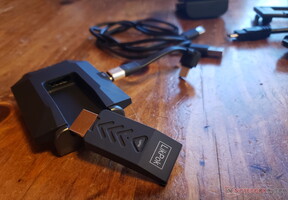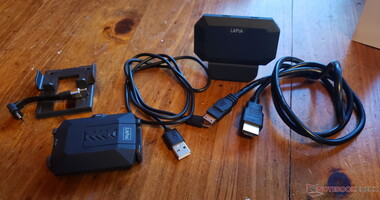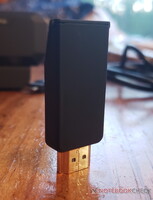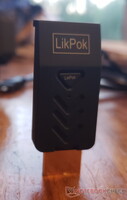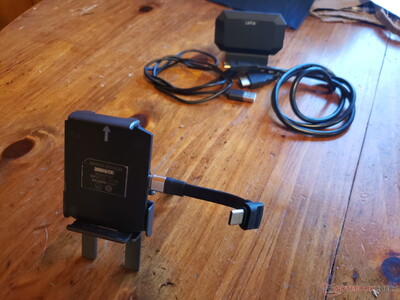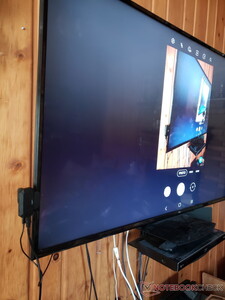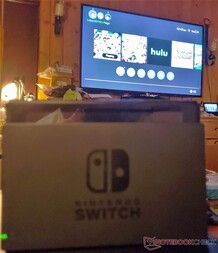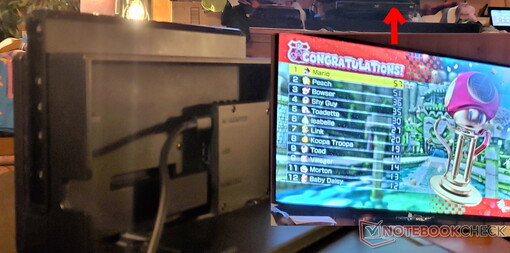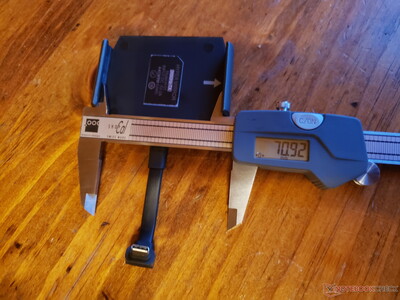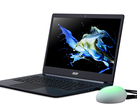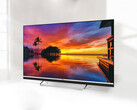LikPok recently launched its Kickstarter campaign for the HYPER MIRROR, a display mirroring solution advertised as a "0-latency" solution for putting the display of your phone, laptop, Nintendo Switch, and more on a TV or monitor without any cables. LikPok also claims that this streaming technique is superior to other technologies, such as Miracast, as the bandwidth the mmWave technology provides allows for "crystal clear, sharp images for a more enjoyable and smooth, perfectly synced casting experience."
We recently received a test unit from LikPok, so in this article, we'll be testing the HYPER MIRROR to see if the product delivers on the campaign's promises.
Impressions
In the box, the HYPER MIRROR includes two main modules. The transmitter is a small HDMI dongle that arrives attached to an expanding phone mount. The mount takes your phone's USB-C connection and turns it into HDMI output for the transmitter. This means this USB-C module serves a dual purpose, both for allowing smartphones to transmit to any HYPER MIRROR receivers and being a simple DP-Alt mode option for laptops without HDMI ports.
Also included is the receiver. It's a small box with mounting holes on the top and bottom. These holes can be used with the supplied plastic mount to attach it to a monitor or TV. The mount includes some grippy padding, so rest assured your lovely screen bezels should stay unscratched. Assuming you have access to 5V USB power somewhere near your monitor and an HDMI port, you should be able to attach it to your screen.
Particularly sharp-eyed readers might notice that the mentioned power adapter on the Kickstarter campaign isn't shown in our photos. LikPok hasn't decided on a particular supplier for the charger yet, so the company didn't ship one with the HYPER MIRROR that was sent to us. As a result, we used conventional USB Type-A wall adapters and the USB port on a TV.
How It Works
LikPok claims that this device uses mmWave technology to transmit its video feed. While we don't have a spectrogram to check precisely what frequency the device runs on, the device's documentation suggests it broadcasts on 60 GHz. 24 GHz to 100 GHz is the range considered the mmWave spectrum, so 60 GHz falls well within that range.
The device also acts as any other high-frequency device does. Almost anything that blocks line-of-sight will interfere with the communication between the transmitter and receiver (which is a limitation of using these high frequencies). Mounting the receiver higher in the air could help reduce interruptions in high foot-traffic spaces of a home.
As far as we're able to tell, there isn't much for encoding, encryption, or translation between the transmitter and the receiver. The manual also notes both the transmitter and receiver have fairly low power consumption levels. We'll dive into this topic more in the testing section.
The technology used here is very similar to the largely abandoned WiGig. While the frequency band is the same, the protocol does not appear to conform to any common or existing standard. As a result, it's very unlikely that any WiGig devices will work with the HYPER MIRROR.
Testing
Setup is fairly simple. The receiver and transmitter paired to each other without any issues. It takes a few seconds for the display feed to start, but after that, the experience with the HYPER MIRROR is pretty good.
Outside of the notable limitations of mmWave devices (you need to make sure the transmitter and receiver are at least facing each other for a solid connection), there weren't any issues with interference or dropout. LikPok claims the transmitter and receiver can communicate at up to five meters apart. Signal dropout due to distance was never an issue during testing.
Getting a good signal with a laptop can be a bit tricky. Depending on how the HDMI port on your laptop is positioned, you may run into communication issues between the HDMI dongle and the receiver. LikPok does mention a 360° HDMI adapter on its campaign page, which would allow you to precisely position the antenna. It might be worth picking one up if you plan on using the HYPER MIRROR with a laptop.
The manual notes that operating temperatures for the HYPER MIRROR transmitter and receiver span from 0 °C to 60 °C. In our testing, we recorded up to 57 °C on the transmitter module in a 28 °C room. We didn't run into any issues with overheating or thermal shutdown of the transmitter.
The video feed provided by the HYPER MIRROR seems to be completely uncompressed as the Kickstarter campaign page claims. LikPok claims that the device has a transmission rate of 3.96 Gbit in the manual, which should be plenty to support uncompressed 1080p video transmission.
HDCP is supported according to the Nvidia Control Panel. However, the HYPER MIRROR seems to identify itself as a repeater. This might cause issues with certain pieces of HDCP-protected content. However, streaming services like Netflix and Hulu worked fine when played through a laptop.
During our testing, we initially had trouble getting the HYPER MIRROR to mirror the screen of a Samsung Galaxy S9. After a bit of troubleshooting, the phone mount ended up failing to output HDMI to the transmitter entirely. However, LikPok was very quick to send us a replacement HYPER MIRROR so we could complete testing.
With this replacement set, the smartphone casting feature worked flawlessly. As long as you don't plan on holding your phone while transmitting (your fingers will block the transmitter's signal), you should have a good time. The included metal stand should work fairly well for ensuring a stable connection with the receiver.
One of the HYPER MIRROR's headline features is the ability to transmit video from a Nintendo Switch to your TV wirelessly. Of course, we decided to test this out. Only having a single cable hanging out of a Switch dock seems a little strange at first, but after a few rounds of Mario Kart, the experience was indistinguishable from a direct HDMI connection. There wasn't any perceivable latency while gaming at 1080p60 nor was there any distracting compression blockiness.
Interestingly, the transmitter is powerful enough to penetrate through the rear plastic door on the Nintendo Switch's dock. Facing the rear of the dock toward the receiver with the dongle plugged in was enough for a smooth, snappy experience with around four meters of space between the transmitter and receiver.
Again, any interference (like a family member or friend walking past your Nintendo Switch) will result in a brief interruption. However, if the interference is resolved in roughly 10 to 15 seconds, the image will instantly snap back to a live view without any rubber banding.
One notable limitation is that you have to use a Nintendo Switch compatible dock with the HDMI dongle, not the mobile phone adapter over USB-C. The smartphone adapter isn't compatible with the way the Nintendo Switch handles video output and won't transmit anything. However, this is far from an issue and really is more of a quirk with the Nintendo Switch than the HYPER MIRROR.
In a future revision of the HYPER MIRROR, it would be nice to see a pass-through HDMI port on the receiver. This would allow you to use the HDMI port the receiver was connected to for other purposes while the device isn't in use, such as a game console or streaming dongle.
Limitations
One thing that doesn't work is HDR content. The HYPER MIRROR doesn't appear to be designed with expanded color ranges in mind. Color format and color space won't always be accurately reported. For instance, an HDR-capable display was reported as SDR while using the HYPER MIRROR.
The maximum resolution we were able to test successfully was 1920x1080 at 60 fps. Trying to cast at 1440p or higher won't work. However, TVs and monitors that support resolutions outside of the supported range by the HYPER MIRROR will still show you those resolutions on your device. The "2K" marketing might confuse some into believing that the HYPER MIRROR can cast up to 1440p, but that is not the case.
Regarding the phone mount, your phone must be 71 mm or wider to attach properly in the mount. The Samsung Galaxy S9 used in our testing was too slim to be attached. However, slipping the S9 into a case resolved the thickness issue. If you own a smaller smartphone, you may run into issues using the phone mount.
Additionally, the HYPER MIRROR isn't literally "zero latency" as the campaign claims. The manual states that latency is less than 2.5 milliseconds, which should be good enough for most people. Outside of brief signal dropouts when something obstructs line-of-sight, there was never any perceivable latency.
Conclusion
With an MSRP of roughly $200, the HYPER MIRROR might be a tough sell for more casual, occasional users. However, for those of you who live in apartments and can't route cables through your walls, this might be exactly what you're looking for.
The HYPER MIRROR works how any 60 GHz device would, including with all of the limitations. The tiny overall footprint of the receiver and transmitter are unique for this technology, making this product hard to compare to anything else available right now.
If you're interested in getting a HYPER MIRROR yourself, you can check out the Kickstarter campaign page here. With any crowd-funded project, be sure to keep in mind that you are funding the project, not directly buying the product.
Disclaimer: The author of this review received the HYPER MIRROR from LikPok free of charge for the purpose of testing.




